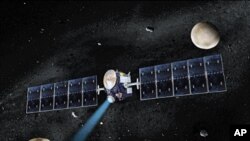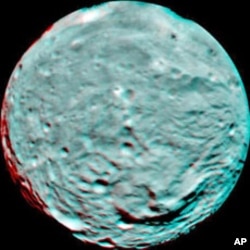NASA’s Dawn spacecraft has returned the first high-resolution images of the asteroid Vesta, the second largest object in the main asteroid belt between Mars and Jupiter.
The U.S. space agency probe began beaming home detailed pictures of Vesta’s ancient, crater-marked surface shortly after entering into orbit around the 530-kilometer-wide rock early Saturday. Dawn - the first spacecraft in history to orbit an object in the main asteroid belt - snapped the intriguing new images from an altitude of only 16,000 kilometers. Ground-based and space telescopes have obtained images of the asteroid, but have not been able to see much detail on its surface.
Dawn will continue to circle Vesta for one year, collecting data and mapping what the mission’s lead scientist Christopher Russell calls “the oldest extant [existing] primordial surface in the solar system.”
Mission managers say unraveling Vesta’s many mysteries will provide a kind of “snapshot” of the earth’s formation more than four billion years ago. That is because Vesta virtually has not changed since that time, whereas Earth has evolved dramatically through the ages.
In addition to discovering the secrets of Vesta's gravity, mineral composition and overall geology, NASA scientists say they specifically want to know why it is the brightest object in the asteroid belt, with a highly-reflective surface three times brighter than Earth’s moon. They also are eager to study a mysterious dark spot that stretches 100 kilometers across the asteroid's jagged landscape.
Dawn reached Vesta after a nearly four-year flight that began in September 2007.
In July 2012, the robotic spacecraft will fire its thrusters to leave Vesta's orbit, and begin a three-year voyage to the largest object in the main asteroid belt, the dwarf planet Cerres. With a diameter of almost 975 kilometers, Cerres is nearly twice as wide as Vesta. NASA says the Dawn probe will spend the final two years of its mission collecting data in orbit around Cerres, and then remain there indefinitely.
















